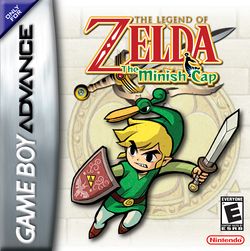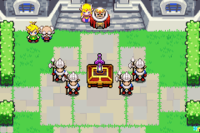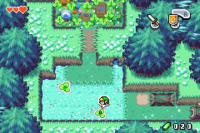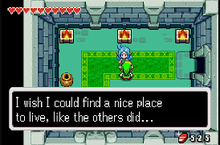| Don't like the ads? Then create an account! Users with accounts have more options than anonymous users. |
The Legend of Zelda: The Minish Cap
| The Legend of Zelda: The Minish Cap | |||||||
|---|---|---|---|---|---|---|---|

| |||||||
| Developer(s) | Capcom, Flagship | ||||||
| Publisher(s) | Nintendo | ||||||
| Release date | Game Boy Advance: Virtual Console (3DS) (Ambassador Program Release): Virtual Console (Wii U): | ||||||
| Genre(s) | Action-adventure | ||||||
| Rating(s) |
| ||||||
| Console(s) | Game Boy Advance, Virtual Console (3DS, Wii U) | ||||||
| Mode(s) | Single player | ||||||
The Legend of Zelda: The Minish Cap is the twelfth game of The Legend of Zelda series. It was released for the Game Boy Advance in 2004 in Japan and Europe and in North America and Australia the following year, 2005. The game stars Link and a talking hat named Ezlo, who must save Hyrule and Princess Zelda from the evil wind sorcerer Vaati while taking advantage of portals along the way to shrink to the size of the Minish people. The game is a prequel to The Legend of Zelda: Four Swords, as it revolves around the backstory of Vaati and the creation of the Four Sword.
In December 2011, The Legend of Zelda: The Minish Cap was re-released for the Nintendo 3DS's Virtual Console, exclusively for Ambassador Program users, as one of the ten free Game Boy Advance games. In 2014, the game was released as a downloadable Wii U Virtual Console title, priced at $7.99.
Story
When starting a new save file, the game's backstory is shown. Years ago, the world was being conquered by evil. The Minish (also called "Picori" by Hyrule) appeared from the sky, granting a sword and a golden light to a young boy dressed in green (who is an earlier incarnation of Link). With wisdom and courage, the boy conquered the darkness and restored peace to the world, earning himself the title, "hero of men". When peace was restored, the people enshrined the blade in a chest and hid it away.
In the present, Princess Zelda visits Link, offering him to visit the Picori Festival with her. It is an annual festival made to commemorate the Minish, and legend states that the Minish come to Hyrule once every one hundred years through a mystical doorway. The current Picori Festival, which Link and Zelda go to, is more notable because it has been one hundred years since the Minish visited. Before Link leaves, Master Smith gives the Smith's Sword to Link, instructing him to the deliver it to Hyrule Castle. The Smith's Sword is the Picori Blade, which would be presented to the winner of the Picori Festival's sword-fighting competition.
Later during the ceremony, the competition's winner, Vaati, shows up for the Picori Blade. Because of Vaati's malicious intent, the castle guards try to stop him from touching the blade. Vaati releases a blue, electrical ball at the Picori Blade, making the sword's handle break off. The Bound Chest then opens, and many monsters are released into Hyrule. Realizing that Zelda has a mysterious power of light, Vaati deems her to be a threat, so he uses a dark spell to turn her into stone. Link tries to defend Zelda, but Vaati's spell knocks him aside. Link lies on the ground unconscious. Vaati is searching for the Light Force, so he looks into the Bound Chest but finds nothing in it. Vaati leaves, continuing his search for the Light Force.
Link wakes up in Hyrule Castle. He goes into the foyer, where King Daltus talks about how the Minish could repair the Picori Blade and break the curse upon Zelda. He instructs Link to go into the Minish Woods and search for the Minish, because they only reveal themselves to children. While exploring Minish Woods, Link encounters two Octoroks attacking a living green hat with a bird-like head. The hat's name is Ezlo, and he introduces himself to Link after being freed. Ezlo decides to join Link but he stays on Link's head because Ezlo cannot move as fast. They soon come across a portal, which shrinks them to Minish size, and using it again returns Link and Ezlo to normal size. Link and Ezlo enter the Minish Village and meet the elder Gentari, who tells them that the Picori Blade can only be reforged using the Four Elements.
During a part of the adventure, Ezlo reveals that he and Vaati are Minish people. Ezlo talks to Link and gives a backstory of when he was a renowned sage and craftsman and Vaati was his apprentice. Ezlo made a hat for the humans, the Mage's Cap, which grants any wish by the wearer. Vaati had put on the hat without Ezlo's permission, and with a lust for power, Vaati wished to become a powerful sorcerer. Vaati then transformed Ezlo into a green hat.
Later in Link's adventure, Vaati impersonates King Daltus and orders the castle soldiers to search for the Light Force. After retrieving the Four Elements, Link takes them to the Elemental Sanctuary, which is also a gateway between Hyrule and the Minish world. Link infuses the energy from the Four Elements to turn the White Sword, which was forged from the broken Picori Blade, into the Four Sword. Link can then access a room with a stained glass windows. The same intro as in the opening is shown but with an additional scene which confirms that the Light Force is within the princess of Hyrule, Princess Zelda. Vaati enters the room (still disguised as King Daltus) and figures out where the Light Force is located. Vaati reveals himself, knocks out Link, and leaves, planning to extract the Light Force from Zelda.
Shortly after, Ezlo wakes up Link, and the two re-enter Hyrule Castle, which has become Dark Hyrule Castle. Link reaches the top of Hyrule Castle and fights Vaati just before he can drain all of Zelda's Light Force, which would have killed her in the process. Link engages in a boss battle against Vaati, who changes his form at parts of the battle.
Link manages to defeat Vaati, causing the Mage's Cap to be released. Link ends up in a room of Hyrule Castle with Zelda, standing in front of the Minish Door. Ezlo returns to his normal form, because the curse on him broke when Link defeated Vaati. Zelda puts on the Mage's Cap and wishes for Vaati's damage unto Hyrule to be undone. After Zelda makes the wish, Ezlo says goodbye to Link and Zelda, and he gifts Link with an actual green cap. Ezlo leaves through the Minish Door, which then vanishes, and the game ends.
Gameplay
The Legend of Zelda: The Minish Cap is a two-dimensional game that retains the core gameplay from earlier The Legend of Zelda installments. It is mostly comparable to its prequel, The Legend of Zelda: Four Swords, which is also for the Game Boy Advance. Like the other games, The Legend of Zelda: The Minish Cap is viewed from a top-down perspective, and has a closer view to the ground than earlier games, allowing for more visual detail. The game takes place within Hyrule, and has an overworld with a variety of environments, most of it being a field; other environments include a forest, a canyon, a swamp, a lake, the clouds, and a graveyard. There are a few dungeons, each with a unique item that is required to defeat the boss and for progressing into the overworld.
Some of the gameplay features are from the three-dimensional The Legend of Zelda games, namely The Legend of Zelda: Ocarina of Time. Several of the Hylian characters debuted in said game. Up to two items can be equipped and assigned to either the A or B button respectively. The item interface is at the top-right corner, and it shows an icon of the item over the button. This makes it similar to the three-dimensional The Legend of Zelda games, although earlier handheld games also have items assigned to the A and B buttons. Pressing the R button makes Link perform a roll, a move which originated from The Legend of Zelda: Ocarina of Time. The combat system is enhanced from previous handheld installments, as Link can learn new sword techniques from the Blade Brothers.
The game has a unique mechanic where Link and Ezlo can enter a portal to shrink to the size of the Minish race. By using the portal again, Link and Ezlo return to their normal size. When Link is Minish size, he has little visibility from the overworld, so his current location is represented by his head within a speech bubble-like icon. It reflects the direction that Link is facing or moving in. At this size, large patches of grass become walls for Link, puddles become large bodies of water, and he can fall into cracks in the ground. The Four Elements and the White Sword are another unique mechanic. The Four Elements can each be infused with the White Sword. As Link infuses more with his sword, he can make more temporary copies of himself from glowing floor panels. These duplicates are required for some puzzles in later parts of the game, such as to push large blocks or to step on a few switches simultaneously.
If Link goes into an area that he can only access at Minish size, such as the Minish Village, the game provides the same zoomed-in view as if Link were normal size. The first dungeon, Deepwood Shrine, is only accessible if Link is Minish size. When Link is at normal size, Deepwood Shrine is a small structure, but at Minish size, it becomes an entire dungeon for Link. From a Minish perspective, common enemies that Link encounters at normal size, such Octoroks, become giant. The first boss, Big Green Chuchu, is a normal ChuChu that Link fights while Minish-sized.
Characters
Playable character
| Sprite | Name | Description |
|---|---|---|
| Link | The main hero and playable character, Link goes on an adventure to stop Vaati from retrieving the Light Force. |
Supporting characters
| Sprite | Name | Description |
|---|---|---|
| Ezlo | ||
| King Daltus | ||
| Minister Potho | ||
| Princess Zelda | ||
| Smith |
Other characters
Enemies
Obstacles
| Sprite | Name | Description |
|---|---|---|
| Boulder | ||
| Chaser | ||
| Door Mimic | ||
| Fire Bar | ||
| Flying Pot | ||
| Stone Statue | ||
| Trap |
Mini-bosses
| Sprite | Name | Description |
|---|---|---|
| Madderpillar | ||
| Dark Nut | ||
| Big Blue Chuchu | ||
| Red Dark Nut | ||
| Black Knight |
Bosses
| Sprite | Name | Description |
|---|---|---|
| Big Green Chuchu | ||
| Gleerok | ||
| Mazaal | ||
| Big Octorok | ||
| Gyorg Pair | ||
| Vaati | ||
| Vaati Reborn | ||
| Vaati Transfigured | ||
| Vaati's Wrath |
Items
| Sprite | Name | Description |
|---|---|---|
| Boomerang | ||
| Bomb | ||
| Bow | ||
| Broken Picori Blade | ||
| Cane of Pacci | The Cane of Pacci sends out a yellow beam capable of flipping certain objects, such as vase portals. The beam can also be fired into a small hole, which Link can launch himself from. | |
| Carlov Medal | ||
| Flame Lantern | ||
| Flippers | ||
| Four Elements (Earth, Fire, Water, Wind) | ||
| Four Sword | ||
| Graveyard Key | ||
| Grip Ring | ||
| Gust Jar | The Gust Jar sucks in nearby items and certain enemies, which can be fired as projectiles. The Gust Jar's suction is required to be used on some objects, such as to steer a lilypad, or on a mushroom so that Link can be flung across a body of water or a pit. | |
| Jabber Nut | ||
| Light Arrow | ||
| Lon Lon Ranch key | ||
| Magical Boomerang | ||
| Map of Hyrule | ||
| Mirror Shield | ||
| Mole Mitts | Allows Link to dig through dirt barriers. | |
| Ocarina of Wind | ||
| Pegasus Boots | ||
| Phonograph | ||
| Power Bracelets | ||
| Remote Bomb | ||
| Roc's Cape | ||
| Small Shield | ||
| Smith's Sword | ||
| Swordsman Newsletter | ||
| Tiger Scroll | ||
| Tingle Trophy | ||
| Wake-Up Mushroom | ||
| White Sword |
Pick-up
These are the main pick-up items.
| Sprite | Name | Description |
|---|---|---|
| Big Key | ||
| Compass | ||
| Dungeon Map | ||
| Heart | ||
| Heart Container | ||
| Joy Butterfly | ||
| Kinstone | ||
| Mysterious Shell | ||
| Piece of Heart | ||
| Rupee | ||
| Small Key |
Bottled items
| Sprite | Name | Description |
|---|---|---|
| Blue Potion | ||
| Din's Charm | ||
| Dog Food | ||
| Fairy | ||
| Farore's Charm | ||
| Lon Lon Milk | ||
| Mt. Crenel Mineral Water | ||
| Nayru's Charm | ||
| Picolyte | ||
| Red Potion | ||
| Water |
Bags and containers
| Sprite | Name | Description |
|---|---|---|
| Bomb Bag | ||
| Empty Bottle | ||
| Kinstone Bag | ||
| Quiver | ||
| Wallet |
Locations
- Castor Wilds
- Cloud Tops
- Eastern Hills
- Elemental Sanctuary
- Fairy Fountain
- Fountain
- Great Fairy Fountain
- Hyrule Castle
- Hyrule Castle Garden
- Hyrule Town - Located at the center of the overworld, Hyrule Town does not have any enemies. Link can do several optional side quests in Hyrule Town, such as play games for prizes, help other characters, and buy items and equipment from stores.
- Lake Hylia
- Lon Lon Ranch
- Melari's Mine
- Minish Village
- Minish Woods
- Mount Crenel
- Royal Crypt
- Royal Valley
- Trilby Highlands
- Veil Falls
- Western Wood
- Wind Ruins
Buildings
- Dampé's Shack
- Figurine Gallery
- Funday School
- Happy Hearth Inn
- Link's House
- Mama's Cafe
- Mayor Hagen's Lakeside Cabin
- Percy's House
- Post Office
- Rem's Shoe Store
- Royal Hyrule Library
- Stockwell's Shop
- Syrup's Hut
Dungeons
- Deepwood Shrine
- Cave of Flames
- Fortress of Winds
- Temple of Droplets
- Palace of Winds
- Dark Hyrule Castle
Development and release
After Capcom and its subsidiary Flagship finished developing the Oracle games, they began work on a new Zelda game for the Game Boy Advance. Work on the title was suspended to allow the teams to focus on The Legend of Zelda: Four Swords, but in February 2003 Shigeru Miyamoto and Eiji Aonuma announced that a The Legend of Zelda game, which would become The Legend of Zelda: The Minish Cap, was under development for the Game Boy Advance.[1]
In an interview with Nintendo of Europe, producer Eiji Aonuma said that The Legend of Zelda: The Minish Cap was given an art style similar to The Legend of Zelda: The Wind Waker, as they they share a common fairy tale-like theme.[2]
The Legend of Zelda: The Minish Cap is the first game of The Legend of Zelda series to be released in Europe before North America. In Europe, the game was released for the holiday season, in November 2004. In North America, the game was released in January 2005, rumored to be because of the Nintendo DS's launch,[3][4] but sources at Nintendo vaguely mentioned "more" was being added in the North American version.[5]
On November 12, 2004, the Zelda Limited Edition Pak bundle was released exclusively in Europe. It consists of a gold Game Boy Advance SP and a copy of The Legend of Zelda: The Minish Cap. Only 25,000 of these units were made.Template:Citation needed
Gallery
- For this game's image gallery, see Gallery:The Legend of Zelda: The Minish Cap.
Names in other languages
| Language | Name | Meaning |
|---|---|---|
| Japanese | ゼルダの伝説 ふしぎのぼうし Zeruda no Densetsu: Fushigi no Bōshi |
The Legend of Zelda: The Mysterious Hat |
Trivia
- The game has a developmental in-joke to the Oracle games for Game Boy Color. In an optional side-quest, Link must aid the three Oracles, Din, Nayru, and Farore, to find a house to stay in. Link can only provide housing for two of them, and although their landlord, Gorman, makes reference to building a third house, this never occurs in the game. There was a third Oracle game, The Legend of Zelda: Mystical Seed of Courage, which revolved around Farore, the Oracle of Secrets, but it was cancelled.
External links
- Official North American website (archived)
- Official European website (mirrored)
- Official Japanese website
References
- ^ "Miyamoto Confirms New Zelda". IGN. Published February 24, 2003.
- ^ Interview with Eiji Aonuma by Nintendo of Europe. landofthelegend.net (archived).
- ^ Minish Cap Site Launches on IGN. Published September 14, 2004.
- ^ ""Zelda: Minish Cap to hit Europe before US". GameSpot (archived). Posted September 3, 2004.
- ^ "Wait" for US Minish Cap on IGN. Published October 19, 2004.
 This article is a stub. You can help Triforce Wiki by expanding it.
This article is a stub. You can help Triforce Wiki by expanding it.





